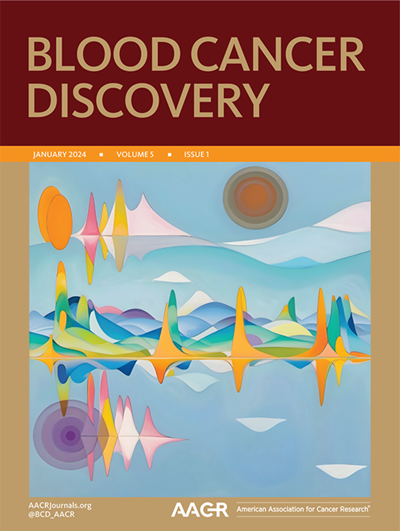Abstract A52: IDS and SETBP1 is highly prognostic in myelodysplastic neoplasms and is a candidate stem cell signature
IF 11.5
Q1 HEMATOLOGY
引用次数: 0
Abstract
Myelodysplastic neoplasms (MDS) are heterogenous blood disorders that arise from dysfunctional hematopoietic stem cells (HSCs) and progenitor cells (HSPCs). According to the cancer stem cell (CSC) model, MDS is organized as a cellular hierarchy that arises from the malignant transformation of HSPCs into rare CSCs. MDS-CSCs are thought to persist during treatment and regenerate disease during relapse. Prior studies have linked MDS-CSCs to MDS-HSPC (Woll et al. Cancer Cell 2014, Pang et al, PNAS 2013, Will et al, Blood 2012), however, a specific cell type has not been isolated and purified as the MDS-CSC. Prognostic gene expression signatures in MDS have also been linked to immature HSPCs (Shiozawa et al, Blood 2017), however, a cell specific signature has not been identified. There is a need to characterize a cell specific gene signature for MDS-CSCs in order to study these cells. To address this need, we performed iterative statistical analyses on MDS gene expression data in order to identify a candidate CSC signature. We hypothesized that by analyzing genes specifically up-regulated in MDS-HSPCs, we can derive a CSC specific gene signature that is not only associated with poor outcomes in MDS, but also marks a subset of cells in MDS with stem cell programs. Up-regulated genes in MDS-HSPCs compared to healthy controls were derived by re-analyzing 73 sorted samples (Woll et al, Cancer Cell 2014) using the limma (Ritchie et al, Nucleic Acids Res 2015). Using these genes, we subsequently analyzed their association with survival in a cohort of 244 MDS patients (Shiozawa et al, Blood 2017, Gerstung et al, Nat Commun 2015, Tyner et al, Nature 2018). We performed iterative Cox proportional hazard models on a training data (n=146), using single and multiple gene combinations. A 2 gene score (i.e., MDS2), comprising IDS and SETBP1, was identified as the most significantly associated feature with decreased survival in MDS compared to Age, Sex, Cytogenetic Risk, and an established MDS score (Shiozawa et al, Blood 2017). Single cell expression of MDS2 was evaluated in MDS scRNA-seq samples (Dussiau et al, BMC Biol2022), and rare cells were identified expressing high levels of MDS2, i.e., MDS2 cells. These cells were integrated with healthy HSPCs. MDS2 cells reside primarily between HSCs and MPPs on a diffusion map, following a differentiation trajectory towards GMPs and monocyte precursors. These observations are consistent with prior studies, as MDS-CSCs were shown to be enriched in HSCs and GMPs (Pang et al, PNAS 2013, Woll et al, Cancer Cell 2014). Analysis of upregulated genes in MDS2 cells revealed that antigen processing, assembly and presentation were the most enriched processes. This analysis supports our approach for identifying a cell specific gene signature, and future work will focus on further single cell analyses and evaluation of CSC content and function of MDS2 cells. Citation Format: Asiri Ediriwickrema, Andrew Gentles, Ravindra Majeti. IDS and SETBP1 is highly prognostic in myelodysplastic neoplasms and is a candidate stem cell signature [abstract]. In: Proceedings of the AACR Special Conference: Acute Myeloid Leukemia and Myelodysplastic Syndrome; 2023 Jan 23-25; Austin, TX. Philadelphia (PA): AACR; Blood Cancer Discov 2023;4(3_Suppl):Abstract nr A52.摘要:IDS和SETBP1在骨髓增生异常肿瘤中具有高度预后作用,是一种候选的干细胞特征
骨髓增生异常肿瘤(MDS)是由造血干细胞(hsc)和祖细胞(HSPCs)功能失调引起的异质血液疾病。根据癌症干细胞(CSC)模型,MDS是由HSPCs恶性转化为罕见的CSC而形成的细胞层次结构。MDS-CSCs被认为在治疗期间持续存在,在复发期间再生疾病。先前的研究已经将MDS-CSCs与MDS-HSPC联系起来(Woll等)。Cancer Cell 2014, Pang et al, PNAS 2013, Will et al, Blood 2012),然而,一种特定的细胞类型尚未被分离和纯化为MDS-CSC。MDS的预后基因表达特征也与未成熟的HSPCs有关(Shiozawa等人,Blood 2017),然而,尚未确定细胞特异性特征。为了研究MDS-CSCs,有必要对其细胞特异性基因特征进行表征。为了满足这一需求,我们对MDS基因表达数据进行了迭代统计分析,以确定候选的CSC特征。我们假设,通过分析MDS- hspcs中特异性上调的基因,我们可以得出CSC特异性基因标记,该标记不仅与MDS的不良预后相关,而且还将MDS中的一部分细胞标记为干细胞程序。与健康对照相比,MDS-HSPCs中的上调基因是通过重新分析73个分类样本(Woll等人,Cancer Cell 2014)使用limma (Ritchie等人,Nucleic Acids Res 2015)得出的。使用这些基因,我们随后分析了它们与244名MDS患者队列中生存的关系(Shiozawa等人,Blood 2017, gersting等人,Nat comm 2015, Tyner等人,Nature 2018)。我们使用单基因和多基因组合对训练数据(n=146)进行了迭代Cox比例风险模型。与年龄、性别、细胞遗传风险和已建立的MDS评分相比,由IDS和SETBP1组成的2个基因评分(即MDS2)被确定为与MDS生存率降低最显著相关的特征(Shiozawa等人,Blood 2017)。我们在MDS scRNA-seq样本中评估了MDS2的单细胞表达(Dussiau等人,BMC Biol2022),并发现了表达高水平MDS2的罕见细胞,即MDS2细胞。这些细胞与健康的造血干细胞结合。在扩散图上,MDS2细胞主要位于造血干细胞和mpp之间,遵循向gmp和单核细胞前体的分化轨迹。这些观察结果与先前的研究一致,因为MDS-CSCs被证明在hsc和gmp中富集(Pang等人,PNAS 2013, Woll等人,Cancer Cell 2014)。对MDS2细胞中上调基因的分析显示,抗原加工、组装和呈递是最富集的过程。该分析支持我们鉴定细胞特异性基因标记的方法,未来的工作将集中在进一步的单细胞分析和评估MDS2细胞的CSC含量和功能。引文格式:Asiri Ediriwickrema, Andrew Gentles, Ravindra Majeti。IDS和SETBP1在骨髓增生异常肿瘤中具有很高的预后价值,是一种候选的干细胞特征[摘要]。摘自:AACR特别会议论文集:急性髓性白血病和骨髓增生异常综合征;2023年1月23-25日;费城(PA): AACR;血癌发现[j]; 2009;4(3 -增刊):摘要/ Abstract
本文章由计算机程序翻译,如有差异,请以英文原文为准。
求助全文
约1分钟内获得全文
求助全文
来源期刊

Blood Cancer Discovery
Multiple-
CiteScore
12.70
自引率
1.80%
发文量
139
期刊介绍:
The journal Blood Cancer Discovery publishes high-quality Research Articles and Briefs that focus on major advances in basic, translational, and clinical research of leukemia, lymphoma, myeloma, and associated diseases. The topics covered include molecular and cellular features of pathogenesis, therapy response and relapse, transcriptional circuits, stem cells, differentiation, microenvironment, metabolism, immunity, mutagenesis, and clonal evolution. These subjects are investigated in both animal disease models and high-dimensional clinical data landscapes.
The journal also welcomes submissions on new pharmacological, biological, and living cell therapies, as well as new diagnostic tools. They are interested in prognostic, diagnostic, and pharmacodynamic biomarkers, and computational and machine learning approaches to personalized medicine. The scope of submissions ranges from preclinical proof of concept to clinical trials and real-world evidence.
Blood Cancer Discovery serves as a forum for diverse ideas that shape future research directions in hematooncology. In addition to Research Articles and Briefs, the journal also publishes Reviews, Perspectives, and Commentaries on topics of broad interest in the field.
 求助内容:
求助内容: 应助结果提醒方式:
应助结果提醒方式:


